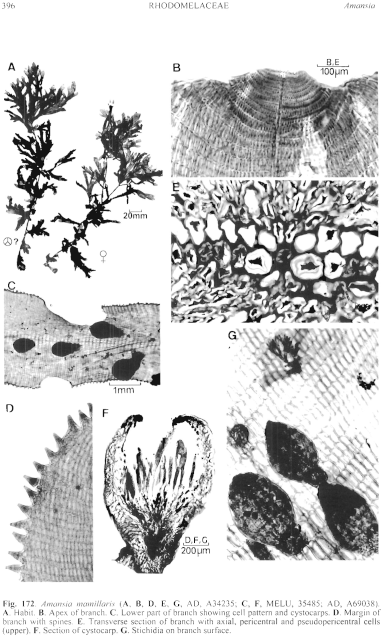|
|
|
|
|
|||||||||||
|
Electronic Flora of South Australia Species Fact Sheet
Phylum Rhodophyta – Family Rhodomelaceae – Tribe Amansieae
Selected citations: J. Agardh 1841: 25; 1863: 1113; 1890: 68; 1892: 172. De Toni 1903: 1089. Harvey 1863, synop.: xv. Kützing 1849: 883. Lucas 1909: 45. May 1965: 396. Norris 1988a: 222. Sonder 1880: 31. Wilson & Kraft 2000: 327.
Thallus (Fig. 172A) medium to dark brown, 10–30 cm high, with corticated, more-or-less terete axes bearing alternately pinnate to bipinnate, complanately branched, basally constricted laterals 4–8 cm long, branches (4–) 6–8 (–10) mm broad, margins smooth to irregular, minutely crenulate (Fig. 172C, D). Holdfast unknown; probably epilithic. Structure. Apices circinnate, with the apical and subapical cells dividing rapidly to form a broad apex (Fig. 172B); axial cells cutting off 5 pericentral cells (Fig. 172E), 2 lateral on each side and probably one ventral, with 2 pseudopericentral cells cut off from the dorsal lateral pericentral cells and 1–3 cut off on the ventral side. Wings 2 cells thick, the layers overlapping at their ends, cells 35–60 µm in diameter and L/D 2–3, with the outermost cells producing multicellular spines 130–180 µm long (Fig. 172D). Midrib slight in upper branches, becoming corticated and 2–3 mm thick below. Trichoblasts scattered on surface of blades, 300–500 µm long. Cells multinucleate; rhodoplasts discoid, chained and reticulate in larger cells.
Reproduction: Procarps unknown. Carposporophytes with a basal fusion cell and short, branched, gonimoblast with elongate-clavate carposporangia 45–70 µm in diameter. Cystocarps (Fig. 172C, F) scattered on branch surface, stalked, ovoid, 0.7–1 mm in diameter; pericarp ostiolate, corticated, 4–5 cells thick. Spermatangia unknown.
Tetrasporangial stichidia (Fig. 172G) scattered on the branch surface between midrib and centre of wings, in groups of 1–5, ovate to slightly elongate, compressed, 300–450 µm broad, lightly corticated, tetrasporangia paired, 70–170 µm in diameter.
Type from "Nov. Holl." (Lamouroux), probably W. Aust.; holotype (a fragment) in Herb. Agardh, LD 42639; isotype in Herb. Lamouroux, CN.
Selected specimens: Separation Point, Geraldton, W. Aust., drift (Kraft & Gabrielson, 15.xii.1980; MELU, 35485). Dongara, W. Aust., drift (Kraft, t, 7.vii.1966; MELU, K1819). Port Denison, W. Aust., drift (Kraft, 14.xii.1971; AD, A41791). Point Peron, W. Aust., drift (Royce 474, 28.i.1950; AD, A15496). Eyre, W. Aust., drift (Woelkerling, 22.xi.1968; AD, A34235).
Distribution: Port Denison to Eyre, W. Australia.
Taxonomic notes: Amansia mamillaris is a deep-water species from the west coast of Australia, with one collection from Eyre on the south coast; it is known only from drift collections and the habit suggests that larger plants may be perennial.
Further studies are needed on its relationships to other species of Amansia, especially in regard to the pericentral and pseudopericentral cell arrangement in young apices.
References:
AGARDH, C.A. (1822). Species Algarum. Vol. 1, Pt 2, pp. 169–398. (Berling: Lund.)
AGARDH, C.A. (1824). Systema Algarum. (Berling: Lund.)
AGARDH, J.G. (1841). In historiam algarum symbolae. Linnaea 15, 1–50, 443–457.
AGARDH, J.G. (1863). Species Genera et Ordines Algarum. Vol. 2, Part 3, pp. 787–1291. (Gleerup: Lund.)
AGARDH, J.G. (1890). Till algernes systematik. Acta Univ. lund. 26(3), 1–125, Plates 1–3.
AGARDH, J.G. (1892). Analecta Algologica. Acta Univ. lund. 28, 1–182, Plates 1–3.
DE TONI, G.B. (1903). Sylloge Algarum omnium hucusque Cognitarum. Vol. 4. Florideae. Sect. 3. pp. 775–1521 + 1523–1525. (Padua.)
HARVEY, W.H. (1863). Phycologia Australica. Vol. 5, Plates 241–300, synop., pp. i-lxxiii. (Reeve: London.)
KÜTZING, F.T. (1849). Species Algarum. (Leipzig.)
LUCAS, A.H.S. (1909). Revised list of the Fucoideae and Florideae of Australia. Proc. Linn. Soc. N.S.W. 34, 9–60.
MAY, V. (1965). A census and key to the species of Rhodophyceae (red algae) recorded from Australia. Contr. N.S. W. Natl Herb. 3, 349–429.
NORRIS, R.E. (1988a). Structure and reproduction of Amansia and Melanamansia gen. nov. (Rhodophyta, Rhodomelaceae) on the southeastern African coast. J. Phycol. 24, 209–223.
SONDER, O.W. (1880). In Mueller, F., Fragmenta Phytographiae Australiae. Supplementum ad volumen undecinum: Algae Australianae hactenus cognitae, pp. 1–42, 105–107. (Melbourne.)
WILSON, S.M. & KRAFT, G.T. (2000). Morphological and taxonomic studies of selected genera from the Tribe Amansieae (Rhodomelaceae, Rhodophyta). Aust. Syst. Bot. 13, 325–372.
The Marine Benthic Flora of Southern Australia Part IIID complete list of references.
Publication:
Womersley, H.B.S. (24 February, 2003)
The Marine Benthic Flora of Southern Australia
Rhodophyta. Part IIID. Ceramiales – Delesseriaceae, Sarcomeniaceae, Rhodomelaceae
Reproduced with permission from The Marine Benthic Flora of Southern Australia Part IIID 2003, by H.B.S. Womersley. Australian Biological Resources Study, Canberra. Copyright Commonwealth of Australia.
Illustration in Womersley Part IIIA, 2003: FIG. 172.

Figure 172 enlarge
Fig. 172. Amansia mamillaris (A, B, D, E, G, AD, A34235; C, F, MELU, 35485; AD, A69038). A. Habit. B. Apex of branch. C. Lower part of branch showing cell pattern and cystocarps. D. Margin of branch with spines. E. Transverse section of branch with axial, pericentral and pseudopericentral cells (upper). F. Section of cystocarp. G. Stichidia on branch surface.

|
Email Contact: State Herbarium of South Australia |

|